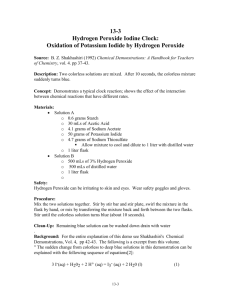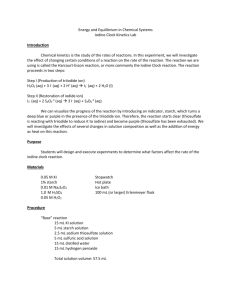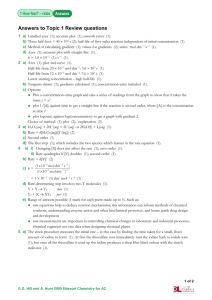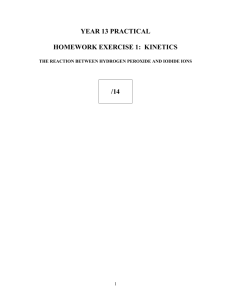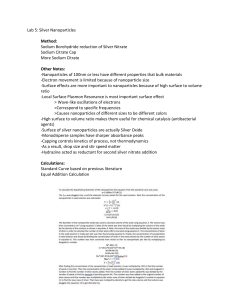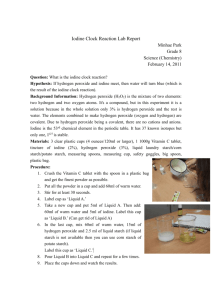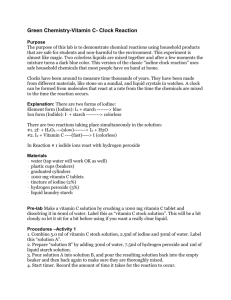A Clock Reaction C12-3
advertisement
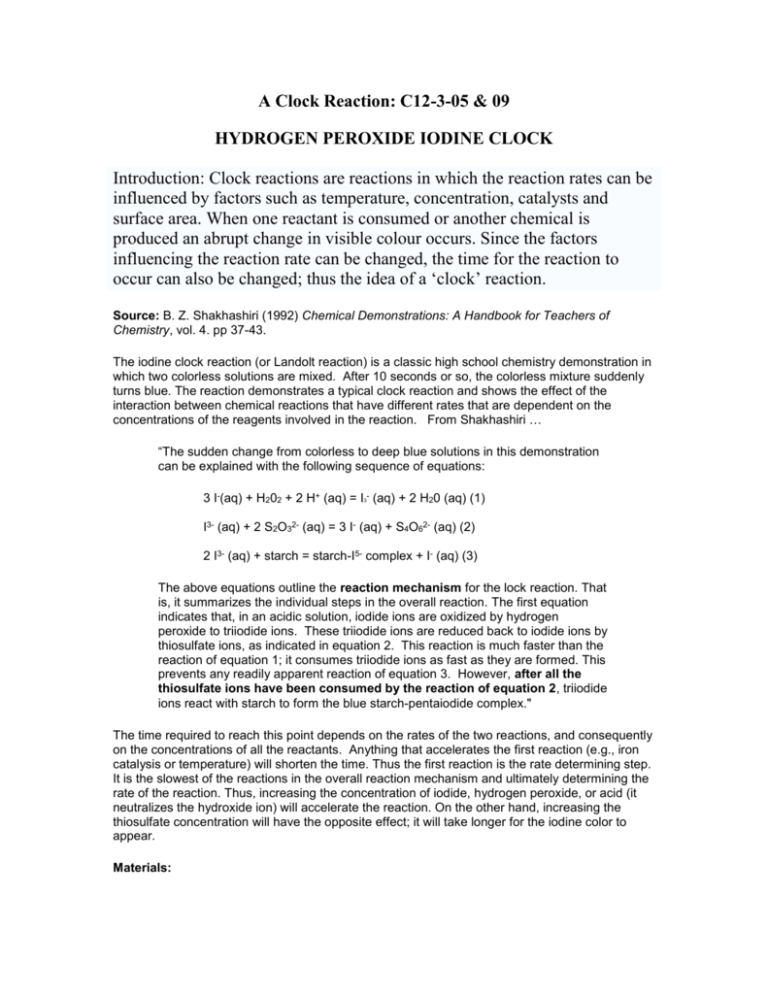
A Clock Reaction: C12-3-05 & 09 HYDROGEN PEROXIDE IODINE CLOCK Introduction: Clock reactions are reactions in which the reaction rates can be influenced by factors such as temperature, concentration, catalysts and surface area. When one reactant is consumed or another chemical is produced an abrupt change in visible colour occurs. Since the factors influencing the reaction rate can be changed, the time for the reaction to occur can also be changed; thus the idea of a ‘clock’ reaction. Source: B. Z. Shakhashiri (1992) Chemical Demonstrations: A Handbook for Teachers of Chemistry, vol. 4. pp 37-43. The iodine clock reaction (or Landolt reaction) is a classic high school chemistry demonstration in which two colorless solutions are mixed. After 10 seconds or so, the colorless mixture suddenly turns blue. The reaction demonstrates a typical clock reaction and shows the effect of the interaction between chemical reactions that have different rates that are dependent on the concentrations of the reagents involved in the reaction. From Shakhashiri … “The sudden change from colorless to deep blue solutions in this demonstration can be explained with the following sequence of equations: 3 I-(aq) + H202 + 2 H+ (aq) = I - (aq) + 2 H20 (aq) (1) 3 I3- (aq) + 2 S2O32- (aq) = 3 I- (aq) + S4O62- (aq) (2) 2 I3- (aq) + starch = starch-I5- complex + I- (aq) (3) The above equations outline the reaction mechanism for the lock reaction. That is, it summarizes the individual steps in the overall reaction. The first equation indicates that, in an acidic solution, iodide ions are oxidized by hydrogen peroxide to triiodide ions. These triiodide ions are reduced back to iodide ions by thiosulfate ions, as indicated in equation 2. This reaction is much faster than the reaction of equation 1; it consumes triiodide ions as fast as they are formed. This prevents any readily apparent reaction of equation 3. However, after all the thiosulfate ions have been consumed by the reaction of equation 2, triiodide ions react with starch to form the blue starch-pentaiodide complex." The time required to reach this point depends on the rates of the two reactions, and consequently on the concentrations of all the reactants. Anything that accelerates the first reaction (e.g., iron catalysis or temperature) will shorten the time. Thus the first reaction is the rate determining step. It is the slowest of the reactions in the overall reaction mechanism and ultimately determining the rate of the reaction. Thus, increasing the concentration of iodide, hydrogen peroxide, or acid (it neutralizes the hydroxide ion) will accelerate the reaction. On the other hand, increasing the thiosulfate concentration will have the opposite effect; it will take longer for the iodine color to appear. Materials: Solution A: · 0.6 grams Starch · 30 mLs of Acetic Acid · 4.1 grams of Sodium Acetate · 50 grams of Potassium Iodide · 4.7 grams of Sodium Thiosulfate Allow mixture to cool and dilute to 1 liter with distilled water Solution B · 500 mLs of 3% Hydrogen Peroxide · 500 mLs of distilled water · 1 liter flask Safety: Hydrogen Peroxide can be irritating to skin and eyes. Wear safety goggles and gloves. The reaction produces iodine that can stain skin and fabric. Iodine can be destroyed by reaction with sodium thiosulfate solution. Do not drink either Solution A or B. Procedure: 1. Mix the two solutions together. Stir by stir bar and stir plate, swirl the mixture in the flask by hand, or mix by transferring the mixture back and forth between the two flasks. Stir until the colorless solution turns blue (about 10 seconds). 2. Describe what is occurring at the molecular level to cause the changes observed. Emphasize the reaction mechanism and the entry to reactions 2 & 3 only when there has been full consumption of reactants. 3. Ask students what factors might influence the reaction rate. Get students to consider at a molecular level why these factors might influence reaction rate. 4. Make adjustments to the reaction as they suggest and as feasible. As an example repeat the procedure but warm Solution A on a hot plate prior to the addition of solution B. 5. Discuss results with reference to Collision Theory. Clean-Up: Any remaining blue solution can be washed down drain with water
